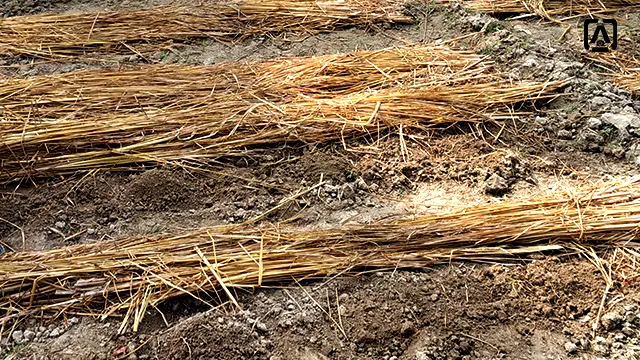Mulching
Mulch
‘Mulch’ is a German
word meaning ‘soft to decay’. It is the layer of any material spread-over the
soil. The material includes (but not limited to) plastic sheet, stones, newspaper,
cardboard, bark chips, leaves, peat moss, straw, etc.
Mulching
Covering of agriculture,
garden or forest soils with organic or inorganic material is called as ‘mulching’.
Mulching improves the soil productivity and makes it aesthetic. Mulching is
done on the field soil, along the tracks, in nursery beds and around the trees.
Advantages
- Mulching is done in order to hold the soil moisture in sandy soil.
- Mulching reduces the fluctuation in temperature and keep soil warm during cold nights, whereas keep the soil cold during hot days.
- Mulching encourages the rapid germination and growth of the seedlings.
- Mulching checks the growth of weed around the transplant by cutting the sunlight.
- Mulching reduces the soil compaction and erosion.
Types of mulches
Mulches are basically of two types. Compost, straw, grass clipping, shredded leaves, wood chips, saw dust, coco peat, peat moss, news paper, cardboard etc., fall under organic mulches, while plastic sheet, stone, gravel, marble, brick chips, etc, fall under inorganic mulches.
A. Organic mulches
1. Compost
Compost is an excellent source of organic carbon as well nitrogen to the plants. All types of composts ranging from the dairy farm compost to the vermicompost work well. Compost increases the water holding capacity of the soils and a layer of 2-3 cm of mulch reduces the day-night fluctuation in temperature.
2. Straw and hay
Straw of rice as well as wheat is cheap and easily available mulch. Straw used as the packaging material of fragile goods and fruit may also be used for mulching purpose. Straw are however, not decomposed easily and thus these mulches are long-lasting.
 |
| Straw of rice used for mulching of Gladiolus |
 |
| Straw of pea used for mulching of bitter gourd |
3. Grass clipping
Grass clippings are easily available from the fields as well as from the lawns. These are easily decomposed into the soils and provide nitrogen. Fresh grass clipping have chances of its own growth and it increases the soil temperature as well, hence grasses to be used for mulching must be well-dried in the sunlight. A 2-3 inch depth of grass mulching is recommended. Mulching with dried-grass clipping enhances the budding in rose cuttings.
 |
| Dried grass clipping used for mulching for rose cuttings |
4. Dry leaves
..
5. Wood chips or shredded bark
..
6. News paper and cardboard
..
7. Sawdust
..
8. Husks of rice
Husks (hulls) are the hard protective covering of the rice separated after milling of paddy. It is abundantly available as by-product in countries, where rice is grown. The hardness of husk is because of opaline silica and lignin materials. Husk of rice has high lignin and fiber contents, hence it is hard to decompose and is long-lasting.
- Husks of rice act as a good organic mulch.
- Husks can easily be spread over the nursery beds to speed-up the germination of seedlings.
- Husks provide good aeration and drainage.
- Husks maintain the soil moisture and check the growth of weeds.
 |
| Husks of rice used for mulching of maize seedlings |
9. Live mulching
..
B. Inorganic mulches
1. Plastic mulching
Plastic sheet is a good material for mulching. Plastic mulching has been widely applied for growing vegetables. Plastic sheet is spread over the soil and holes or slits are made for growing the crops. Plastic sheets of various size, thickness and colors are easily available in the markets, which can be used as mulch for growing vegetable in ridges and furrows.
Mulching the soils with plastic sheet retains the soil moisture, maintain the required temperature, check the growth of weeds, reduce the fertilizer leaching and reduces the soil compaction. Mulching also holds the methyl bromide used for soil fumigation.
Beside the numerous advantages, plastic mulching has several disadvantages too. The cost of plastic sheet and the tool and techniques used for its application are additional expenses. Further, non-biodegradability of plastic sheet is threat to the soil health. However, proper removal of used plastic and recycling can reduces the environmental issues.
Mulching the soils with plastic sheet retains the soil moisture, maintain the required temperature, check the growth of weeds, reduce the fertilizer leaching and reduces the soil compaction. Mulching also holds the methyl bromide used for soil fumigation.
Beside the numerous advantages, plastic mulching has several disadvantages too. The cost of plastic sheet and the tool and techniques used for its application are additional expenses. Further, non-biodegradability of plastic sheet is threat to the soil health. However, proper removal of used plastic and recycling can reduces the environmental issues.
 |
| Plastic mulching used for growing zucchini |
Content first created on 07-06-2020
last updated on 30-05-2023
last updated on 30-05-2023





0 Comments
Leave your comments here.